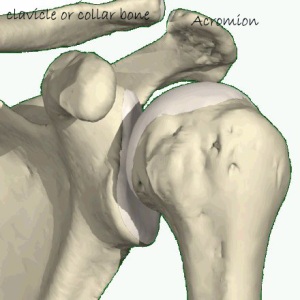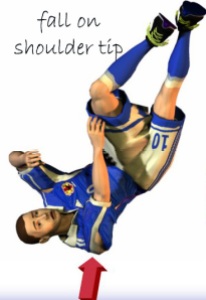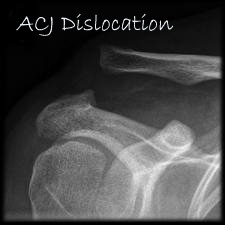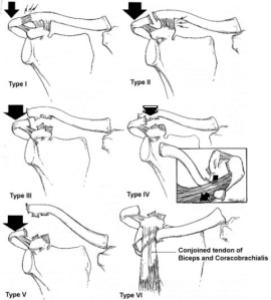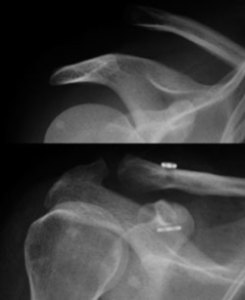The acromio-clavicular joint is situated above the shoulder joint and is where the outer end of the collar bone meets with the bone of the shoulder blade.
Acromio-clavicular joint injuries tend to occur in contact sports such as rugby and football as well as fall from bicycle or motorcycle. The usual mechanism of injury is a fall onto the tip of the shoulder under significant force or momentum.
The trauma of the fall onto the point of the shoulder may tear the acromio-clavicular ligaments as well as result in apparent superior subluxation of the clavicle (in-fact downwards displacement of the acromion).
The forces from the fall can lead to rupture of the coracoclavicular ligaments leading to complete dislocation of the joint. The latter injuries may be classified by severity with a view to guiding treatment, both operative and non-operative.
The patient will experience pain in the shoulder region together with difficulty in lifting up the arm of the affected shoulder. There may be a swelling of the ACJ due to the injury.
The x-rays will show a separation of the acromio-clavicular joint. This is sometimes termed “shoulder separation” as opposed to “shoulder dislocation”.
The treatment depends on the severity of the acromio-clavicular joint dislocation.
Doctors classify the dislocation based on the x-ray appearances and grade them accordingly.
We generally use the Rockwood’s classification:
The main issue is the integrity of the coraco-clavicular ligaments.
In a nutshell, once the coraco-clavicular ligament (labelled as “ligament torn” in the above diagram) is disrupted, the distal end of the collar bone will tend to lift up with respect to the acromion. In fact, the real situation is that the acromion sags downwards with respect to the distal end of the collar bone. This produces the swelling and prominence seen in patients.
If you refer to the Rockwood’s classification, Types I to II have intact coraco-clavicular ligaments. In these patients, the prominence or deformity of the bony bump is minimal.
In Types III to VI, the coraco-clavicular ligaments are disrupted and hence the distal end of the collar bone (clavicle) tends to appear elevated.
Types IV to VI generally require surgical treatment for a good outcome.
Type III can be treated with or without surgery. In most patients, non-surgical treatment leads to reasonably good results. However, in some of these Type III patients, the joint can become painful or sore. The upper limb may become weaker as well.
Hence some of my patients do opt for surgery in Type III separations.
Others who are not keen for surgery can have a trial of non-surgical treatment via physiotherapy. If they become symptomatic later on, delayed surgery can still be done.
It should be noted that without surgery, Type III bony prominence will be permanent. The joint does not reduce on its own when treated conservatively.
Type I and II injuries were once thought to be harmless and have good outcomes with physiotherapy alone.
However, I am seeing more and more patients with chronic pain and swelling in the joint even though x-rays showed Type I or II injuries. I believe it is due to the cartilage injury to the joint which occurred at the time of the accident. Surgical treatment using arthroscopic resection of the distal clavicle can be offered in these patients.
The Type III to Type VI separations can be treated surgically. This is an example using the Arthrex tightrope technique for a Type V injury:
For other shoulder conditions and treatments, click on the links below and learn more:
Dislocation
Separation
Frozen Shoulder


